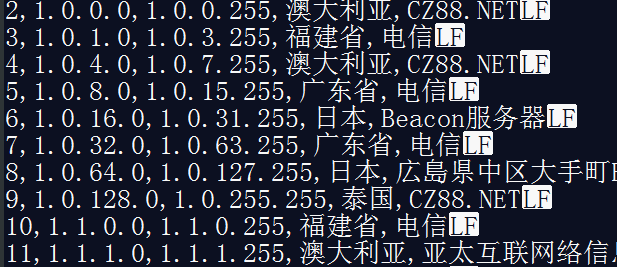python读取文本数据写入到数据库及查询优化
2016-08-28 14:08
691 查看
文本数据格式

ip2int函数用于IP地址转化为整数
int2ip函数用于整数转化为IP地址
insert_row函数用于插入数据库记录
from __future__ import print_function
import torndb
def get_mysql_conn():
return torndb.Connection(
host=mysql["host"] + ":" + mysql["port"],
database=mysql["database"],
user=mysql["user"],
password=mysql["password"],
charset="utf8")
mysql = {
"host": "127.0.0.1",
"port": "3306",
"database": "test",
"password": "",
"user": "root",
"charset": "utf8"
}
def ip2int(ip):
try:
hexn = ''.join(["%02X" % long(i) for i in ip.split('.')])
except Exception, e:
hexn = ''.join(["%02X" % long(i) for i in '0.0.0.0'.split('.')])
return long(hexn, 16)
def int2ip(n):
d = 256 * 256 * 256
q = []
while d > 0:
m,n = divmod(n,d)
q.append(str(m))
d = d/256
return '.'.join(q)
def insert_row():
with open("./ipdata.csv", 'r') as fr:
lines = fr.readlines()
nl_p_list = []
for l in lines:
ls = l.strip().split(',', 4)
c1, c2, c3, c4, c5 = ls[0], ip2int(ls[1]), ip2int(ls[2]), ls[3], ls[4]
nl = [c2, c3, c4, c5]
nl_p_list.append(nl)
db = get_mysql_conn()
db.execute("START TRANSACTION")
for i in range(len(nl_p_list)/1000 + 1):
tmp_nl_p_list = nl_p_list[i*1000: (i+1)*1000]
ret = db.insertmany('insert into ipdata (startip, endip, country, carrier) values (%s, %s, %s, %s)', tmp_nl_p_list)
db.execute("COMMIT")
if __name__ == '__main__':
insert_row()
# print(ip2int('106.39.222.36'))
with open("./ipdata.csv", 'r') as fr:
lines = fr.readlines()
nl_p_list = []
for l in lines:
ls = l.strip().split(',', 4)
c1, c2, c3, c4, c5 = ls[0], ip2int(ls[1]), ip2int(ls[2]), ls[3], ls[4]
nl = [c2, c3, c4, c5]
nl_p_list.append(nl)
import random
import time
ip_list = map(lambda x: x[1], random.sample(nl_p_list, 100))
db = get_mysql_conn()
ret_list = []
#{0}表名
sql_tmp = 'select {0}.* from (SELECT * FROM `test`.ipdata where %s>=startip order by startip Desc limit 1) {0}'
sql_list = []
#拼接一个很长的sql
for i in range(len(ip_list)):
sql_list.append(sql_tmp.format('t' + str(i)) % ip_list[i])
sql = ' union all '.join(sql_list)
t0 = time.time()
# for row in db.query(sql):
# print(row)
dict(zip(ip_list, db.query(sql)))
t1 = time.time()
for ip in ip_list:
ret = db.get('SELECT * FROM `test`.ipdata where %s>=startip order by startip Desc limit 1', ip)
startip, endip = ret.get('startip'), ret.get('endip')
if startip <= ip <= endip:
ret_list.append((ip, ret.get('country')))
else:
ret_list.append((ip, u"unknown"))
t2 = time.time()
print(t1-t0)
print(t2-t1)
格式化输出字符串函数format()
使用字符串的参数使用{NUM}进行表示,0, 表示第一个参数,1, 表示第二个参数, 以后顺次递加;
zip()函数接受任意多个(包括0个和1个)序列作为参数,返回一个tuple列表
dict()函数是从可迭代对象来创建新字典。比如一个元组组成的列表
参考文章:
Python标准库:内置函数dict
http://www.2cto.com/kf/201411/354739.html
优化的途径:
字段加索引效率提高1000倍
使用union all一次查询查出
本文出自 “点滴积累” 博客,请务必保留此出处http://tianxingzhe.blog.51cto.com/3390077/1727003

ip2int函数用于IP地址转化为整数
int2ip函数用于整数转化为IP地址
insert_row函数用于插入数据库记录
from __future__ import print_function
import torndb
def get_mysql_conn():
return torndb.Connection(
host=mysql["host"] + ":" + mysql["port"],
database=mysql["database"],
user=mysql["user"],
password=mysql["password"],
charset="utf8")
mysql = {
"host": "127.0.0.1",
"port": "3306",
"database": "test",
"password": "",
"user": "root",
"charset": "utf8"
}
def ip2int(ip):
try:
hexn = ''.join(["%02X" % long(i) for i in ip.split('.')])
except Exception, e:
hexn = ''.join(["%02X" % long(i) for i in '0.0.0.0'.split('.')])
return long(hexn, 16)
def int2ip(n):
d = 256 * 256 * 256
q = []
while d > 0:
m,n = divmod(n,d)
q.append(str(m))
d = d/256
return '.'.join(q)
def insert_row():
with open("./ipdata.csv", 'r') as fr:
lines = fr.readlines()
nl_p_list = []
for l in lines:
ls = l.strip().split(',', 4)
c1, c2, c3, c4, c5 = ls[0], ip2int(ls[1]), ip2int(ls[2]), ls[3], ls[4]
nl = [c2, c3, c4, c5]
nl_p_list.append(nl)
db = get_mysql_conn()
db.execute("START TRANSACTION")
for i in range(len(nl_p_list)/1000 + 1):
tmp_nl_p_list = nl_p_list[i*1000: (i+1)*1000]
ret = db.insertmany('insert into ipdata (startip, endip, country, carrier) values (%s, %s, %s, %s)', tmp_nl_p_list)
db.execute("COMMIT")
if __name__ == '__main__':
insert_row()
# print(ip2int('106.39.222.36'))
with open("./ipdata.csv", 'r') as fr:
lines = fr.readlines()
nl_p_list = []
for l in lines:
ls = l.strip().split(',', 4)
c1, c2, c3, c4, c5 = ls[0], ip2int(ls[1]), ip2int(ls[2]), ls[3], ls[4]
nl = [c2, c3, c4, c5]
nl_p_list.append(nl)
import random
import time
ip_list = map(lambda x: x[1], random.sample(nl_p_list, 100))
db = get_mysql_conn()
ret_list = []
#{0}表名
sql_tmp = 'select {0}.* from (SELECT * FROM `test`.ipdata where %s>=startip order by startip Desc limit 1) {0}'
sql_list = []
#拼接一个很长的sql
for i in range(len(ip_list)):
sql_list.append(sql_tmp.format('t' + str(i)) % ip_list[i])
sql = ' union all '.join(sql_list)
t0 = time.time()
# for row in db.query(sql):
# print(row)
dict(zip(ip_list, db.query(sql)))
t1 = time.time()
for ip in ip_list:
ret = db.get('SELECT * FROM `test`.ipdata where %s>=startip order by startip Desc limit 1', ip)
startip, endip = ret.get('startip'), ret.get('endip')
if startip <= ip <= endip:
ret_list.append((ip, ret.get('country')))
else:
ret_list.append((ip, u"unknown"))
t2 = time.time()
print(t1-t0)
print(t2-t1)
格式化输出字符串函数format()
使用字符串的参数使用{NUM}进行表示,0, 表示第一个参数,1, 表示第二个参数, 以后顺次递加;
zip()函数接受任意多个(包括0个和1个)序列作为参数,返回一个tuple列表
dict()函数是从可迭代对象来创建新字典。比如一个元组组成的列表
参考文章:
Python标准库:内置函数dict
http://www.2cto.com/kf/201411/354739.html
优化的途径:
字段加索引效率提高1000倍
使用union all一次查询查出
本文出自 “点滴积累” 博客,请务必保留此出处http://tianxingzhe.blog.51cto.com/3390077/1727003
相关文章推荐
- python读取文本数据写入到数据库及查询优化
- ObjectARX中调用ADO封装类实现数据库查询读取写入数据的一个类实例
- Python从数据库读取大量数据批量写入文件
- 查询数据库数据并写入到文件中的优化方案
- ObjectARX中调用ADO封装类实现数据库查询读取写入数据的一个类实例
- python3将csv文件中的两列数据读取出来,并且按行写入txt文本之中
- 数据库SQLite 数据大量存储 和快速读取 链表查询的优化 使用gosn
- 模块-----向数据库里面建表,写入数据,在读取数据
- 2000W条数据的Oralce数据库SQL查询优化经验 - 机会总会留给有准备的人
- 子查询,从数据库中第三条 后的数据开始读取,(超简单)怕有时候记不住。呵呵!
- 用 Python 的输入输出功能读取和写入数据
- 2000W条数据的Oralce数据库SQL查询优化经验 - 机会总会留给有准备的人
- 使用Apache POI创建Excel,并从数据库中读取数据写入到Excel文件中
- PHP 读取文本文件内容写入数据库
- 关于数据库image数据类型数据的读取和写入
- 2000W条数据的Oralce数据库SQL查询优化经验 - 机会总会留给有准备的人
- 如何优化数据库中数据的查询
- 从数据库中读取数据,并写入xml文件中(dom4j)
- 从数据库读取数据写入excel并调用Winrar加密压缩输出
- 2000W条数据的Oralce数据库SQL查询优化经验 - 机会总会留给有准备的人
